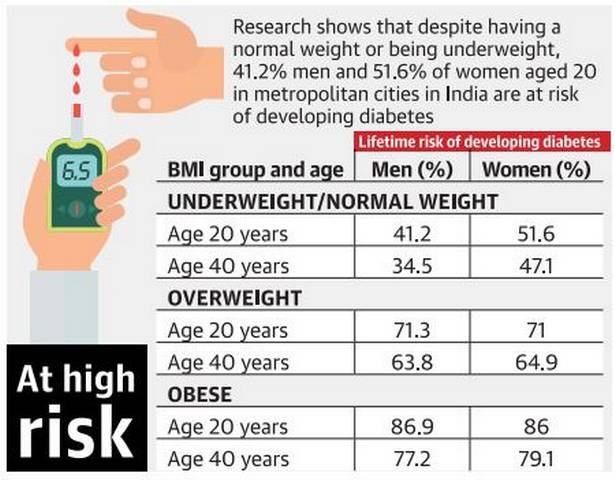Social Justice
Hidden Epidemic
- 30 Nov 2020
- 5 min read
Why In News
A new research published recently in Diabetologia (journal of the European Association for the Study of Diabetes) highlights the vulnerability of indian youth towards diabetes.
Key Points
- The research titled “Lifetime risk of diabetes in metropolitan cities in India,’’ was done by a team of authors in India, U.K. and U.S., led by Shammi Luhar, Department of Public Health and Primary Care, University of Cambridge, U.K.
- Findings of the study:
- More than half of men (55%) and two thirds (65%) of women aged 20 years in India are more likely to develop diabetes, with most of those cases (around 95%) likely to be type 2 diabetes (T2D) in their lifetime.
- Type 2 diabetes:
- It affects the way the body uses insulin. While the body still makes insulin, unlike in type I, the cells in the body do not respond to it as effectively as they once did.
- The population with 45 and above age groups is the most affected with it.
- This is the most common type of diabetes and it has strong links with obesity.
- Type 2 diabetes:
- Lifetime risk of developing diabetes in 20 year old men and women free of diabetes today is 56% and 65%, respectively.
- Obesity has a significant impact on vulnerability to diabetes.
- 86% higher among 20 year old women and 87% among men of metropolitan area.
- India currently has 77 million adults who have diabetes and this number is expected to almost double to 134 million by 2045.
- Women generally had a higher lifetime risk of developing diabetes across their lifespan.
- Remaining lifetime risk of developing diabetes declined with age. As per researchers, those currently aged 60 years and free of diabetes, are less likely to develop diabetes in their remaining life.
- More than half of men (55%) and two thirds (65%) of women aged 20 years in India are more likely to develop diabetes, with most of those cases (around 95%) likely to be type 2 diabetes (T2D) in their lifetime.
- Sources of data for the study:
- Sex and BMI-specific incidence rates of diabetes in urban India taken from the Centre for Cardiometabolic Risk Reduction in South Asia (2010–2018);
- age, sex and urban-specific rates of mortality from period lifetables reported by the Government of India (2014);
- Prevalence of diabetes from the Indian Council for Medical Research India Diabetes study (2008–2015).
- Impact of high probabilities of developing diabetes:
- Overburdening of already strained health Infrastructure of the country.
- Increase out-of-pocket expenditure on diabetes treatment by patients.
- Causes of such high incidences of diabetes:
- Urbanisation
- Decreasing diet quality
- Decreased levels of physical activity
- Prevention or postponing diabetes by effective lifestyle modification, such as:
- Following a healthy diet
- Increasing physical activity
- Reducing body weight in those who are obese or overweight
Diabetes
- Diabetes is a Non-Communicable Disease (NCD) that occurs either when the pancreas does not produce enough insulin (a hormone that regulates blood sugar, or glucose), or when the body cannot effectively use the insulin it produces.
- Types:
- Type I diabetes: It is also known as juvenile diabetes (as it mostly affects children of age 14-16 years), this type occurs when the body fails to produce sufficient insulin. People with type I diabetes are insulin-dependent, which means they must take artificial insulin daily to stay alive.
- Gestational diabetes: This type occurs in women during pregnancy when the body sometimes becomes less sensitive to insulin. Gestational diabetes does not occur in all women and usually resolves after giving birth.
- Diabetes affects the five major organs namely, Kidney, Heart, Blood vessels, Nervous System, and Eyes (retina).
- The factors responsible for the increase in diabetes are an unhealthy diet, lack of physical activity, harmful use of alcohol, overweight/obesity, tobacco use, etc.







